What Commercial Property Owners Should Know About Winterizing
The recent wave of below-freezing temperatures across the country was, for some, an unpleasant reminder of the importance of winterizing one’s property. Power outages, burst pipes and water leaks were widespread, resulting in wasted time, money and resources for countless homeowners and businesses.
Setting aside the potential causes why, there’s no question that we’re seeing more extreme cold weather in areas of the country that the existing infrastructure isn’t equipped to support. Buildings in Minneapolis might be designed to withstand a wind chill of 15 below, but buildings in Atlanta aren’t.
When pipes experience more than six hours of below-freezing temperatures, their likelihood of failure increases considerably. In buildings that are likely to be unoccupied for longer periods during extreme winter weather—such as schools, commercial buildings or churches—a burst pipe might not be detected for days, all but ensuring a major flooding incident where the cost of repair can be substantial.
With the National Oceanic and Atmospheric Administration predicting wetter-than-usual weather and increased flooding in areas extending all the way down to the Gulf Coast and mid-Atlantic, commercial property owners should be considering how they can prevent damage to their properties during the remaining months of winter.
Elements of a Winterizing Plan
The larger a building is, the more pipe it has exposed to the elements, which increases the likelihood of freezing during periods of prolonged cold weather. Whereas a small office building typically has hundreds of feet of piping, a larger commercial building might have thousands of feet. Insulating those pipes is one of the best things you can do to protect against freezing, although it’s not a foolproof way of preventing cracks or bursts, particularly in areas like basements or garages where temperatures can dip much lower.
Because of this, property owners should monitor conditions inside and outside their buildings as closely as possible and take steps to reduce the likelihood of cracked pipes:
- If you’ll be away from your property for a sustained period, set your thermostat to maintain an indoor temperature of no lower than 55 degrees F. This will keep your heating bills relatively low while ensuring that the interior is warm enough to prevent pipes from freezing.
- Wherever possible, leave all interior doors open. If doors are closed in an area of your building that’s naturally cold, the temperature may not get up to the necessary level. Air circulation throughout the interior can help prevent a freeze from happening.
- Identify any low-lying areas inside and outside your building where water can pool up. If water pools on a concrete floor next to a boiler, then expands, it can easily crack the boiler and cause it to start leaking.
- Take special care to monitor any basements or garages, as their temperatures can drop rapidly. Hot water heaters are often located in garages, but the pipes that carry cold water into those heaters are frequently uninsulated.
- Make sure to have an emergency battery-powered electricity supply in case the power goes out. Electricity is essential not just for running an HVAC system, but also for powering Wi-Fi, which can be used as a backup for sending alerts from a leak protection system.
The Importance of Leak Detection Technology
Leak detection technology has become increasingly accurate and affordable in recent years, making it a cost-efficient option for commercial property owners looking to minimize the damage caused by burst pipes during severe winter weather.
While earlier generations of sensors were only capable of detecting water on a surface and sending an alarm, today’s devices incorporate AI machine learning to detect changes in water flow and usage patterns without the need for direct contact. As the devices learn over time, they recognize when to alert a user, such as when a building’s water flow suddenly spikes during a time it normally doesn’t.
Property owners evaluating leak detection technology might feel overwhelmed by the abundance of choices available. One possible solution is to work with companies that aggregate the best leak prevention technology from multiple sources rather than manufacturing it themselves. This model not only ensures more reliable sensors, warranty coverage and scalability, it also offers protection against potential future supply chain disruptions.
Installing leak prevention technology also puts building owners in a strong position to negotiate with insurers, who might lower premiums or offer incentives for mitigating risk. As the effectiveness of leak prevention technology becomes irrefutable in the coming years, we’re likely to see it become standardized in the same way that fire sprinklers were decades ago.
Creating a Plan of Action
Everybody expects a burst pipe to happen to somebody else. But as we’ve already seen this winter, hoping for the best is a strategy that can quickly, and expensively, backfire.
The good news is that winterizing your buildings can be a relatively quick and noninvasive process. It’s also much less expensive than the cost of fixing the damage from a burst pipe after the fact.
So, take the time to understand where and when your properties are most at risk. Then, develop a plan that combines insulation, leak prevention technology and regular monitoring and maintenance. You’ll be glad you did.
About the Author
Michael P. Murphy
Michael P. Murphy is CSO of InsureTEK, a pioneering B2B platform aggregator that integrates building sensors, installation, insurance, financing and artificial intelligence/machine learning to predict, mitigate and minimize building owners’ loss from water damage and other perils.
